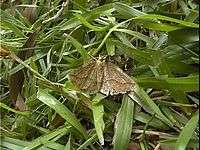Ischalis variabilis
| Ischalis variabilis | |
|---|---|
 | |
| Scientific classification | |
| Kingdom: | Animalia |
| Phylum: | Arthropoda |
| Class: | Insecta |
| Order: | Lepidoptera |
| Family: | Geometridae |
| Genus: | Ischalis |
| Species: | I. variabilis |
| Binomial name | |
| Ischalis variabilis (Meyrick, 1909) | |
| Synonyms | |
| |
Ischalis variabilis is a moth of the family Geometridae. It is endemic to New Zealand, where it is widespread in the North and South islands.[1]
There are two to three distinct transverse lines on the forewing. Both sexes have four discal spots which are usually visible dorsally as well as ventrally. Adults have been recorded year round, except June on the North Island. The main flight period is October to March. There seem to be two generations per year, but may breed continuously during mild winters.
The eggs are usually deposited in January and February. They are almost hemispherical, slightly ovate, flattened, pale bluish-green in colour, covered with numerous very slight hexagonal depressions. As the enclosed embryo develops, small irregular reddish-brown patches appear on the surface of the egg-shell.
The larvae have been recorded feeding on Cyathea and Dicksonia species. First-instar larva are very pale ochreous-brown, with two wavy orange-red subdorsal lines. Full-grown larvae are about 32 mm long and pale rusty-brown with an obscure pale-brown dorsal line. Pupation takes place in a pupa enclosed in a curled fern leaf or hidden amongst leaf litter on the ground.